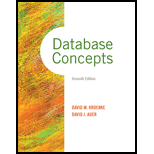
Database Concepts (7th Edition)
7th Edition
ISBN: 9780133544626
Author: David M. Kroenke, David J. Auer
Publisher: PEARSON
expand_more
expand_more
format_list_bulleted
Concept explainers
Question
Chapter 6, Problem 6.49RQ
Program Plan Intro
A database is a collection of information that is organized in a specific order so that it can be accessed easily, managed and updated.
- It supports storage and manipulation of data.
- Data stored in a database are organized into rows, columns and tables. Each data is indexed which makes it easier to find the relevant information.
- Rows are also called as records are a group of fields within a table which are related to a specific entity.
- New information can be added, deleted or updated in the database.
Database administrator:
- For multiuser database or inter-organizational database, the procedure becomes more important and difficult.
- For the large internet and intranet databases, the responsible for database administration is too time consuming and it’s difficult to handle even by the full-time person.
- So to handle these large applications, the person who has both technical and diplomatic skill is usually required to handle this situation, which can be tackled by an office of the database administration.
- The manager of the office is known as database administrator.
Expert Solution & Answer
Want to see the full answer?
Check out a sample textbook solution
Students have asked these similar questions
I need help in explaining how I can demonstrate how the Laplace & Inverse transformations behaves in MATLAB transformation (ex: LIke in graph or something else)
You have made the Web solution with Node.js. please let me know what problems and benefits I would experience while making the Web solution here, as compared to any other Web solution you have developed in the past.
what problems and benefits/things to keep in mind as someone just learning
PHP is the server-side scripting language. MySQL is used with PHP to store all the data. EXPLAIN in details how to install and run the PHP/MySQL on your computer. List the issues and challenges I may encounter while making this set-up?
why I asked: I currently have issues logging into http://localhost/phpmyadmin/ and I tried using the command prompt in administrator to reset the password but I got the error LOCALHOST PORT not found.
Chapter 6 Solutions
Database Concepts (7th Edition)
Ch. 6 - Prob. 6.1RQCh. 6 - Explain how database administration tasks vary...Ch. 6 - Prob. 6.3RQCh. 6 - Prob. 6.4RQCh. 6 - Prob. 6.5RQCh. 6 - Prob. 6.6RQCh. 6 - Prob. 6.8RQCh. 6 - Prob. 6.9RQCh. 6 - Prob. 6.10RQCh. 6 - Prob. 6.11RQ
Ch. 6 - Prob. 6.12RQCh. 6 - Prob. 6.13RQCh. 6 - Prob. 6.14RQCh. 6 - Prob. 6.15RQCh. 6 - Prob. 6.16RQCh. 6 - Prob. 6.17RQCh. 6 - Prob. 6.18RQCh. 6 - Explain the benefits of marking transaction...Ch. 6 - Explain the use of the SQL transaction control...Ch. 6 - Prob. 6.21RQCh. 6 - Describe statement-level consistency.Ch. 6 - Prob. 6.23RQCh. 6 - Prob. 6.24RQCh. 6 - Prob. 6.25RQCh. 6 - Prob. 6.26RQCh. 6 - Prob. 6.27RQCh. 6 - Explain what serializable isolation level is. Give...Ch. 6 - Explain the term cursor.Ch. 6 - Prob. 6.30RQCh. 6 - What is the advantage of using different types of...Ch. 6 - Explain forward-only cursors. Give an example of...Ch. 6 - Explain static cursors. Give an example of their...Ch. 6 - Prob. 6.34RQCh. 6 - Prob. 6.36RQCh. 6 - Prob. 6.37RQCh. 6 - Describe the advantages and disadvantages of...Ch. 6 - Prob. 6.40RQCh. 6 - Prob. 6.41RQCh. 6 - Prob. 6.42RQCh. 6 - Prob. 6.44RQCh. 6 - Prob. 6.45RQCh. 6 - What is the advantage of making frequent...Ch. 6 - Summarize a DBAs responsibilities for managing...Ch. 6 - Prob. 6.48RQCh. 6 - Prob. 6.49RQCh. 6 - Prob. 6.50E
Knowledge Booster
Learn more about
Need a deep-dive on the concept behind this application? Look no further. Learn more about this topic, computer-science and related others by exploring similar questions and additional content below.Similar questions
- Capsim Team PowerPoint Presentations - Slide Title: Key LearningsWhat were the key learnings that you discovered as a team through your Capsim simulation?arrow_forwardWrite the SQL code that permits to implement the tables: Student and Transcript. NB: Add the constraints on the attributes – keys and other.arrow_forwardDraw an ERD that will involve the entity types: Professor, Student, Department and Course. Be sure to add relationship types, key attributes, attributes and multiplicity on the ERD.arrow_forward
arrow_back_ios
SEE MORE QUESTIONS
arrow_forward_ios
Recommended textbooks for you

 Principles of Information Systems (MindTap Course...Computer ScienceISBN:9781285867168Author:Ralph Stair, George ReynoldsPublisher:Cengage Learning
Principles of Information Systems (MindTap Course...Computer ScienceISBN:9781285867168Author:Ralph Stair, George ReynoldsPublisher:Cengage Learning Database Systems: Design, Implementation, & Manag...Computer ScienceISBN:9781305627482Author:Carlos Coronel, Steven MorrisPublisher:Cengage Learning
Database Systems: Design, Implementation, & Manag...Computer ScienceISBN:9781305627482Author:Carlos Coronel, Steven MorrisPublisher:Cengage Learning Database Systems: Design, Implementation, & Manag...Computer ScienceISBN:9781337627900Author:Carlos Coronel, Steven MorrisPublisher:Cengage Learning
Database Systems: Design, Implementation, & Manag...Computer ScienceISBN:9781337627900Author:Carlos Coronel, Steven MorrisPublisher:Cengage Learning Database Systems: Design, Implementation, & Manag...Computer ScienceISBN:9781285196145Author:Steven, Steven Morris, Carlos Coronel, Carlos, Coronel, Carlos; Morris, Carlos Coronel and Steven Morris, Carlos Coronel; Steven Morris, Steven Morris; Carlos CoronelPublisher:Cengage Learning
Database Systems: Design, Implementation, & Manag...Computer ScienceISBN:9781285196145Author:Steven, Steven Morris, Carlos Coronel, Carlos, Coronel, Carlos; Morris, Carlos Coronel and Steven Morris, Carlos Coronel; Steven Morris, Steven Morris; Carlos CoronelPublisher:Cengage Learning Principles of Information Systems (MindTap Course...Computer ScienceISBN:9781305971776Author:Ralph Stair, George ReynoldsPublisher:Cengage Learning
Principles of Information Systems (MindTap Course...Computer ScienceISBN:9781305971776Author:Ralph Stair, George ReynoldsPublisher:Cengage Learning


Principles of Information Systems (MindTap Course...
Computer Science
ISBN:9781285867168
Author:Ralph Stair, George Reynolds
Publisher:Cengage Learning

Database Systems: Design, Implementation, & Manag...
Computer Science
ISBN:9781305627482
Author:Carlos Coronel, Steven Morris
Publisher:Cengage Learning

Database Systems: Design, Implementation, & Manag...
Computer Science
ISBN:9781337627900
Author:Carlos Coronel, Steven Morris
Publisher:Cengage Learning

Database Systems: Design, Implementation, & Manag...
Computer Science
ISBN:9781285196145
Author:Steven, Steven Morris, Carlos Coronel, Carlos, Coronel, Carlos; Morris, Carlos Coronel and Steven Morris, Carlos Coronel; Steven Morris, Steven Morris; Carlos Coronel
Publisher:Cengage Learning

Principles of Information Systems (MindTap Course...
Computer Science
ISBN:9781305971776
Author:Ralph Stair, George Reynolds
Publisher:Cengage Learning